Chinese tea culture
Chinese tea culture refers to how tea is prepared as well as the occasions when people consume tea in China. Tea culture in China differs from that in European countries like Britain and other East and Southeast Asian countries like Japan, Korea, Vietnam in preparation, taste, and occasion when it is consumed. Tea is still consumed regularly, both on casual and formal occasions. In addition to being a popular beverage, it is used in traditional Chinese medicine as well as in Chinese cuisine.
| Chinese tea culture | |||||||
|---|---|---|---|---|---|---|---|
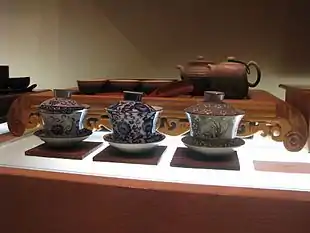 | |||||||
| Traditional Chinese | 中國茶文化 | ||||||
| Simplified Chinese | 中国茶文化 | ||||||
| |||||||
| Alternative Chinese name | |||||||
| Traditional Chinese | 茶藝 | ||||||
| Simplified Chinese | 茶艺 | ||||||
| |||||||
Etymology
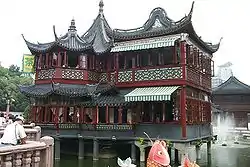
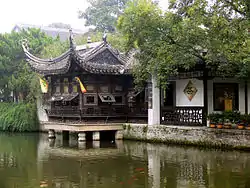
The concept of tea culture is referred to in Chinese as chayi ("the art of drinking tea"), or cha wenhua ("tea culture"). The word cha (茶) denotes the beverage that is derived from Camellia sinensis, the tea plant. Prior to the 8th century BCE, tea was known collectively under the term 荼 (pinyin: tú) along with a great number of other bitter plants. These two Chinese characters are identical, with the exception of an additional horizontal stroke in the Chinese lettering 荼, which translates to tea. The older character is made up of the radical 艸 (pinyin: cǎo) in its reduced form of 艹 and the character 余 (pinyin: yú), which gives the phonetic cue.
Tea drinking customs
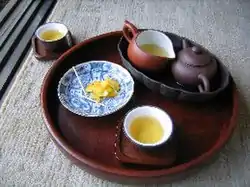
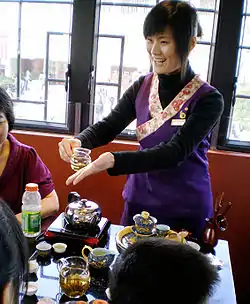
There are several special circumstances in which tea is prepared and consumed in Chinese culture, and is preserved completely in Mainland China and Taiwan.
- A sign of respect
- According to Chinese tradition, members of the younger generation should show their respect to members of the older generation by offering a cup of tea. Inviting their elders to restaurants for tea is a traditional holiday activity. In the past, people of a lower social class served tea to the upper class in society. Today, with the increasing liberalization of Chinese society, this rule and its connotations have become blurred.
- To apologize
- In Chinese culture, tea may be offered as part of a formal apology. For example, children who have misbehaved may serve tea to their parents as a sign of regret and submission.
- To show gratitude and celebrate weddings
- In the traditional Chinese marriage ceremony, the bride and groom kneel in front of their respective parents and serve them tea and then thank them, together which represents an expression of their gratitude and respect. According to the tradition, the bride serves the groom's family, and the groom serves the bride's family. This process symbolizes the joining together of the two families.
Finger tapping
Light finger tapping is an informal way to thank the tea master or tea server for tea. While or after one's cup is filled, the receiver of the tea may tap the index and middle fingers (one or more in combination) to express gratitude to the person who served the tea.[1] This custom is common in southern Chinese, where their meals often are accompanied by many servings of tea.
This custom is said to have originated in the Qing dynasty when the Qianlong Emperor traveled in disguise throughout the empire and his accompanying servants were instructed not to reveal their master's identity. One day in a restaurant, the emperor poured tea for a servant. To that servant it was a huge honor to have the emperor pour him a cup of tea. Out of habit, he wanted to kneel and express his thanks to the emperor, but he could not do this since that would reveal the emperor's identity. Instead, he tapped the table with bent fingers to represent kneeling to the Emperor and to express his gratitude and respect. In this sense, the bent fingers supposedly signify a bowing servant.
In formal tea ceremonies nodding the head or saying "thank you" is more appropriate.
Brewing Chinese tea

The different ways of brewing Chinese tea depend on variables like the formality of the occasion, the means of the people preparing it, and the kind of tea being brewed. For example, green teas are more delicate than oolong teas or black teas; therefore, green tea should be brewed with cooler water. The most informal method of brewing tea is to simply add the leaves to a pot containing hot water. This method is commonly found in households and restaurants, for example, in the context of dim sum or yum cha in Cantonese restaurants. Another method for serving tea is to use a small lidded bowl called a gaiwan. The Hongwu Emperor of the Ming dynasty contributed to the development of loose tea brewing by banning the production of compressed tea.
Gongfu cha (Kung fu tea)
Gongfu cha, meaning "making tea with skill", is a popular method of preparing tea in China. It makes use of small Yixing teapots holding about 100–150 ml (4 or 5 fl.oz.), the size being thought to enhance the aesthetics and to "round out" the taste of the tea being brewed. Brewing tea in a Yixing teapot can be done for private enjoyment as well as to welcome guests. Depending on the region of China, there may be differences in the steps of brewing as well as the tools used in the process. For example, Taiwanese-style gongfu cha makes use of several additional instruments including tweezers and a tea strainer. The procedure is mostly applicable to oolong teas, but it is some used to make pu'er and other fermented teas.
Influence on Chinese culture
Tea has had a major influence on the development of Chinese culture, and Chinese traditional culture is closely connected with Chinese tea. Tea is often associated with literature, arts, and philosophy and is closely connected with Taoism, Buddhism and Confucianism. Roughly since the Tang Dynasty, drinking tea has been an essential part of self-cultivation. Chinese Chan (similar to Japanese Zen) philosophy is also linked with drinking tea.
Teaware
Traditionally, tea drinkers were regarded as the 'academic' and 'cultural elites' of the society. The practice of drinking tea was considered to be an expression of personal morality, education, social principles, and status. Increased enthusiasm for tea drinking led to the greater production of teaware, which significantly popularized Chinese porcelain culture.
Teahouse
.jpg.webp)
Ancient Chinese scholars used the teahouse as a place for sharing ideas. The teahouse was a place where political allegiances and social rank were said to have been temporarily suspended in favor of an honest and rational discourse. The leisurely consumption of tea promoted conviviality and civility amongst the participants. The teahouse is not only a minor by-product of Chinese tea culture; it offers historical evidence of Chinese tea history. Today, people can also sense a kind of humanistic atmosphere in Beijing's Lao She Teahouse and in other teahouses in East China cities like Hangzhou, Suzhou, Yangzhou, Nanjing, Wuxi, Shaoxing, Shanghai, and other places. The teahouse atmosphere is still dynamic and vigorous.
Modern culture
In modern China, virtually every dwelling—even down to the simplest mud hut—has a set of tea implements for brewing a cup of hot tea. They are symbols of welcome for visitors or neighbors. Traditionally, a visitor to a Chinese home is expected to sit down and drink tea while talking; visiting while remaining standing is considered uncouth. Folding the napkin in tea ceremonies is a traditional act in China performed to keep away bad qi energy. In Taiwan, tea ceremonies are held not only in daily life but also on important occasions.
Tea was regarded as one of the seven daily necessities, the others being firewood, rice, oil, salt, soy sauce, and vinegar. There are several types of tea: green tea, oolong tea, red tea, black tea, white tea, yellow tea, puerh tea and flower tea. Traditionally, fresh tea leaves are regularly turned over in a deep bowl. This process allows the leaves dry in a way that preserves their full flavor, ready for use.
See also
- Chinese tea ceremony schools
- China National Tea Museum
- Chinese social relations
- Gongfu tea ceremony
- Tea classics
- Teaism
- The Classic of Tea
- Yum cha
- Tea-picking opera
- Tea pet
References
- Parkinson, Rhonda. "The Origin of Finger Tapping - Chinese Tea History". About.com. Retrieved 1 May 2013.
